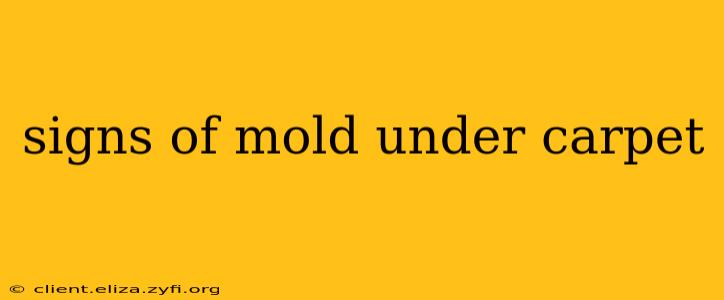Mold infestations beneath carpeting are a significant concern, impacting indoor air quality and potentially causing health problems. Identifying the signs early is crucial for mitigating damage and ensuring a healthy home environment. This guide details the telltale signs of mold under your carpet, offering advice on what to do if you suspect a problem.
What are the signs of mold under carpet?
This is often the most pressing question homeowners have. Unfortunately, mold under carpet is usually hidden, making early detection challenging. However, several clues can indicate its presence:
-
Musty Odor: A persistent, earthy, or musty smell emanating from your carpeted areas is a major red flag. This odor is often the first and most noticeable sign of mold growth, even before visible signs appear. The smell might be more pronounced in humid weather or after cleaning.
-
Visible Mold: While often hidden, sometimes mold might be visible at the edges of the carpet where it meets the walls, under furniture, or in areas with high humidity. Look for discoloration – black, green, gray, or brown stains.
-
Water Stains: Dark, damp patches or stains on your carpet are strong indicators of past water damage, which is a breeding ground for mold. These stains might be accompanied by a musty smell.
-
Allergic Reactions: If you or your family members experience increased allergy or asthma symptoms when spending time in a particular carpeted room, mold might be the culprit. Symptoms such as sneezing, coughing, itchy eyes, and difficulty breathing could be indicators.
-
Discolored or Bulging Carpet: The carpet itself might show signs of damage from moisture. Look for areas where the carpet appears discolored, darker than the surrounding area, or unusually bulging. This could suggest underlying moisture and potential mold growth.
How do I know if it's mold or something else?
It's important to distinguish mold from other potential causes of discoloration or odor. Other issues might mimic the signs of mold, including:
-
Pet Urine: Pet accidents can cause stains and odors that resemble mold. A strong ammonia smell is a key difference.
-
Spilled Liquids: Spilled liquids, especially those containing dyes or sugars, can leave stains that might be mistaken for mold.
-
Natural Carpet Discoloration: Some carpets naturally fade or discolor over time due to wear and tear or exposure to sunlight.
If you're unsure, it's always best to err on the side of caution and investigate further.
What are the health risks of mold under carpet?
Mold exposure can lead to a range of health problems, especially for those with pre-existing respiratory conditions. These potential health risks include:
-
Respiratory Issues: Mold spores can trigger allergic reactions, asthma attacks, and other respiratory problems.
-
Infections: In immunocompromised individuals, mold can cause serious infections.
-
Other Health Problems: In some cases, mold exposure has been linked to more severe health problems, though further research is needed to fully understand the long-term effects.
It's crucial to address any suspected mold infestation promptly to minimize health risks.
How can I test for mold under carpet?
While home testing kits exist, they aren't always conclusive for mold under carpet. A professional mold inspection is recommended to accurately determine the extent of the problem. Professionals use specialized equipment to detect hidden mold growth and assess the level of contamination.
How do I remove mold from under carpet?
Removing mold from under carpeting is a complex process and often involves professional help. Attempting DIY remediation without proper equipment and expertise can be ineffective and even dangerous. A professional will assess the situation, determine the extent of the damage, and recommend the best course of action, which may involve:
-
Carpet Removal: In many cases, complete carpet removal and disposal is necessary to effectively eliminate mold.
-
Moisture Mitigation: Addressing the source of the moisture is critical to prevent future mold growth.
-
Subfloor Remediation: If the mold has penetrated the subfloor, extensive repairs or replacement may be required.
-
Professional Cleaning and Sanitization: Once the affected area is thoroughly dried and repaired, professional sanitization is necessary to eliminate any remaining mold spores.
Remember: Early detection and professional intervention are key to addressing mold under carpet effectively and safeguarding your health and home. Don't hesitate to contact a mold remediation specialist if you suspect a problem.
